Black snakes are common in the US. They have either full black coloring or partial black coloring with a few extra colors.
Identification can be one of the biggest issues when differentiating between different species of black snakes due to the lack of large distinguishing marks.
Table of Contents
Types of Black Snakes
The following species are known for their mostly black coloring. These species are common throughout the country.
1. North American Racer
Scientific name: Coluber constrictor
Venomous: No
The North American Racer is also known as the Racer snake, Black Racer, and South American racer. Its natural habitat includes Southern parts of the country expanding to the Midwest.

These snakes are highly common around forests and in areas of Florida.
North American Racers are a type of all-black snake. They have a black body and a blackhead.
Further characterization includes smooth boy scales that almost don’t look separated from each other.
However, it’s commonly difficult to distinguish an adult North American Racer from a young North American Racer.
Young members of the genus have a gray body with red and light color markings looking almost like a completely different species.
Many young North American Racers are confused with the highly dangerous and venomous Pygmy rattlesnake as a result.
The species gets its name from its capacity to constrict its prey. However, most adult snakes aren’t known for constricting their prey as they prefer to swallow it alive.
Fast hunting and fast-moving around characterize the North American Racer. This snake quickly follows prey and swallows it.
The same quick movements are characteristic when seeing people. This snake prefers to run away instead of biting.
You can see a North American Racer only when it exists its nest to hunt. Otherwise, he spends most of his life underground.

2. Eastern Ratsnake
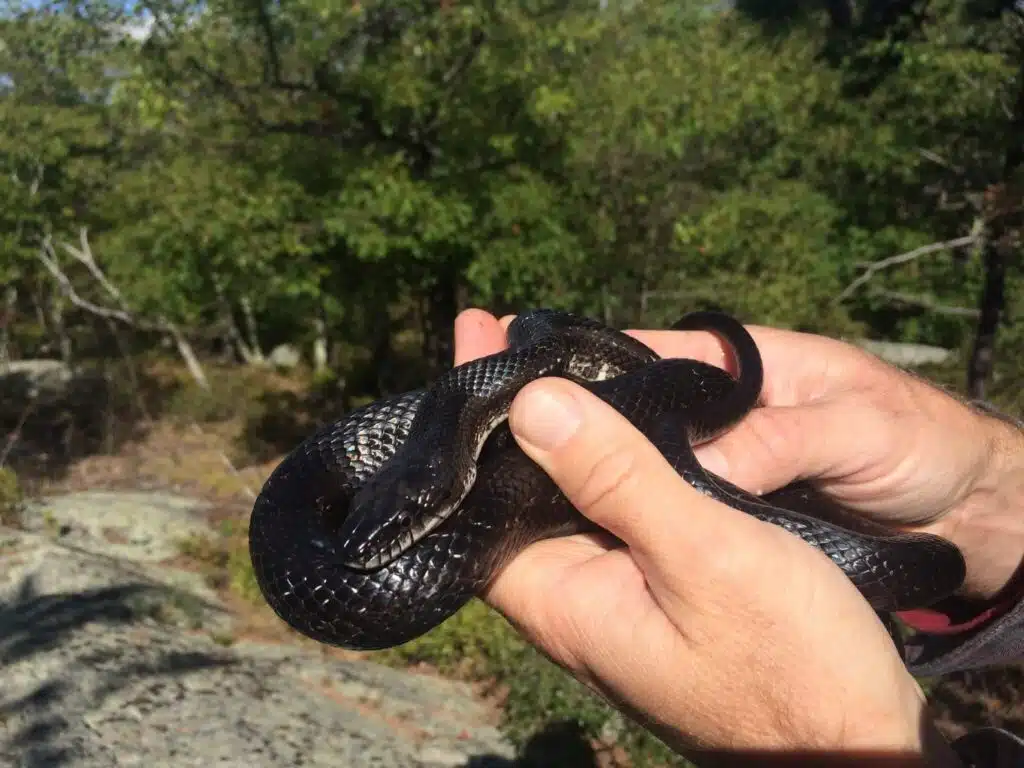
Scientific name: Pantherophis alleghaniensis
Venomous: No
The Eastern Ratsnake is also commonly known as the Black Rat Snake and the Pilot Black snake.
Eastern Ratsnakes are highly common around homes where they aren’t afraid to seek shelter since many rodents are attracted to food traces around the house.
These snakes also live in forests and wetlands, particularly in warm climates as they like to warm up in the sun during the day.
Eastern Ratsnakes can be identified as almost entirely black bodies. They have white coloring under the chin.
These snakes also exhibit white marks on the belly towards the head as the belly towards the tail is mostly gray.
As in with the North American Racer, the Eastern Ratsnake looks different as a juvenile than as an adult.
As their name suggests, these snakes are mostly interested in preying on rodents such as rats. They are opportunistic killers going for a wide range of rodents regardless of their size.
An adult Eastern Ratsnake easily measures between 36 and 72 inches. This makes it a medium-sized snake that has few natural predators.
The most exposed members of this species are juveniles as they are shorter.
Some of the most common predators of juvenile Eastern Ratsnakes are cats as these snakes are commonly found around the house.
Outside suburban areas, these juvenile snakes face common enemies such as foxes and raccoons.
3. Black Kingsnake
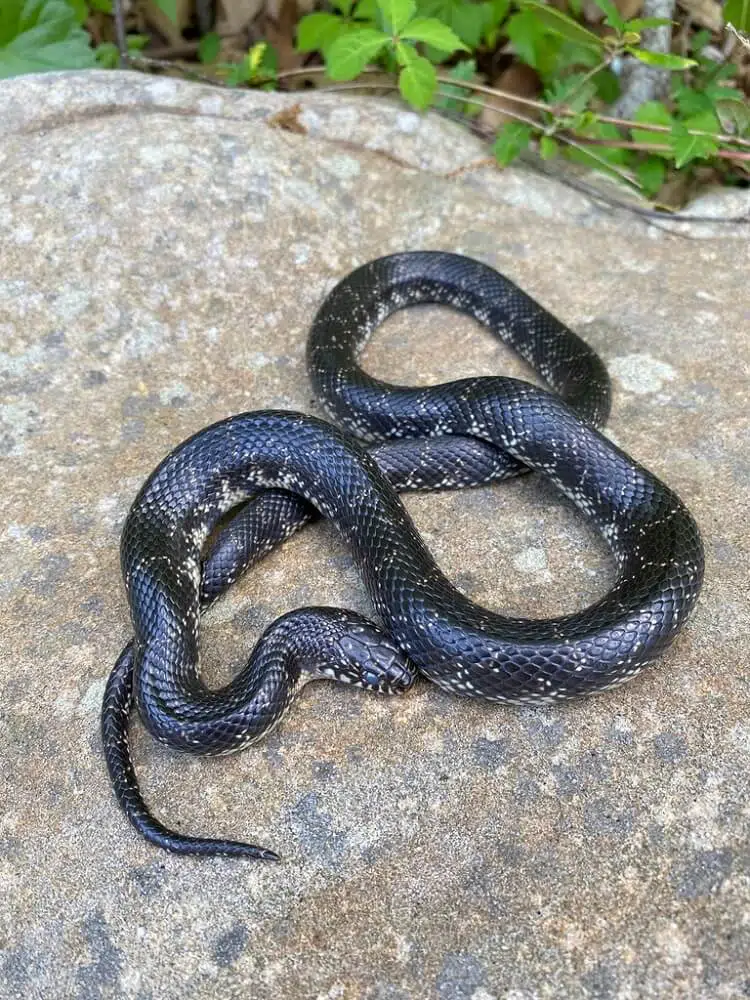
Scientific name: Lampropeltis nigra
Venomous: No
The Black Kingsnake is one of the most common species in certain Southeastern and Eastern states. This snake is almost entirely black.
As its name suggests, the black snake is truly black with a black dorsal and a black belly. This snake has yellow or white speckles along the sides.
As one of the most common snakes in the US, it’s not difficult to find. While it can live around homes, it prefers to live next to abandoned buildings such as abandoned farms.
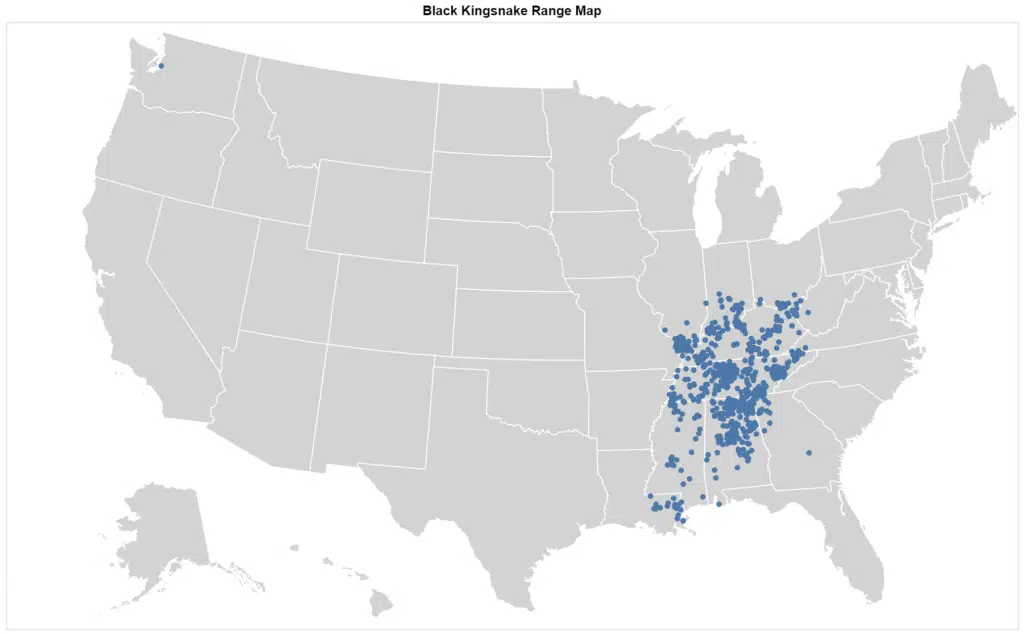
The Black Kingsnake is also highly common around floodplains. It lives here as there are high chances of finding rodents and other prey here.
This species is considered of medium to large size compared to other black snakes in the US.
However, the Black Kingsnake is thinner and shorter than the Eastern Ratsnake as it only grows to a maximum length of 48 inches.
These snakes aren’t considered particularly dangerous to humans.
However, they have a few defense mechanisms they can use against people and other predators. For example, they vibrate their tails before an attack.
These snakes can also bite if handles. It’s best to step away from Black Kingsnakes when seeing them out in nature.
4. Eastern Kingsnake
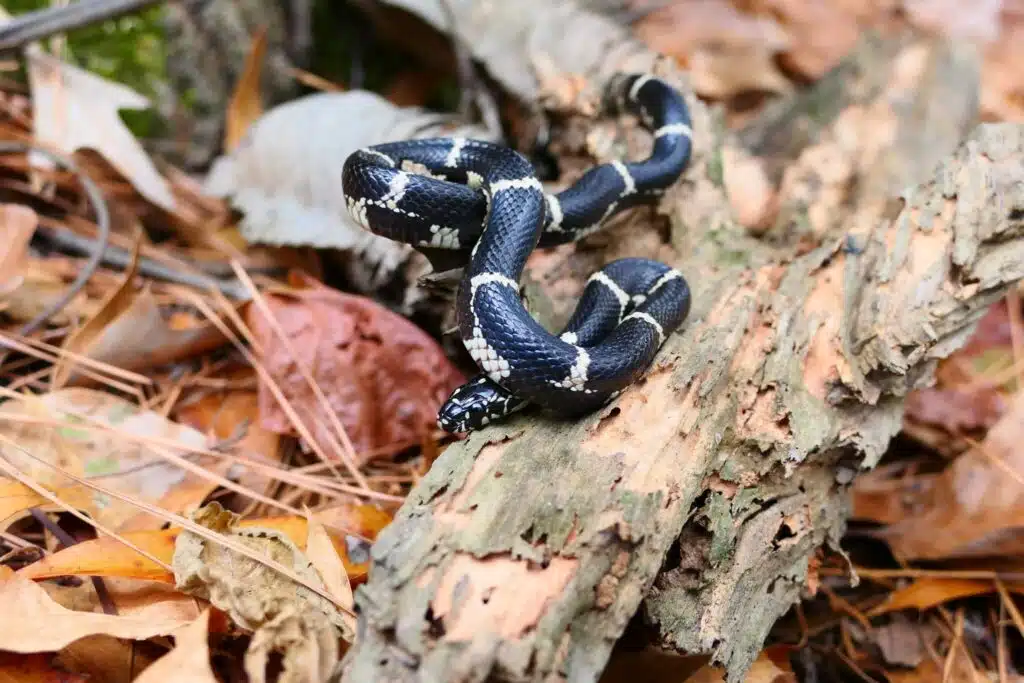
Scientific name: Lampropeltis getula
Venomous: No
The Eastern Kingsnake is sometimes referred to as the Common kingsnake or the Chain kingsnake.
This species is common both among collectors and in states such as Florida, Texas, Arizona, and California.
Identification is easy since the species has a mostly black body which can sometimes be blue-black given there are 9 subspecies of the Eastern Kingsnake.
Its most prevalent color is black, however.
This snake is also known as a fearless snake that commonly eats mammals and even other snakes.
Eastern Kingsnakes have developed defensive mechanisms that allow them to hunt and kill venomous snakes including Copperheads.
This snake also eats lizards, frogs, and rodents.
Despite its wide diet and its capacity to eat venomous snakes, the Eastern Kingsnake remains small compared to other black snakes. Most examples grow up to 39 inches even if captive examples can grow as long as 80 inches.
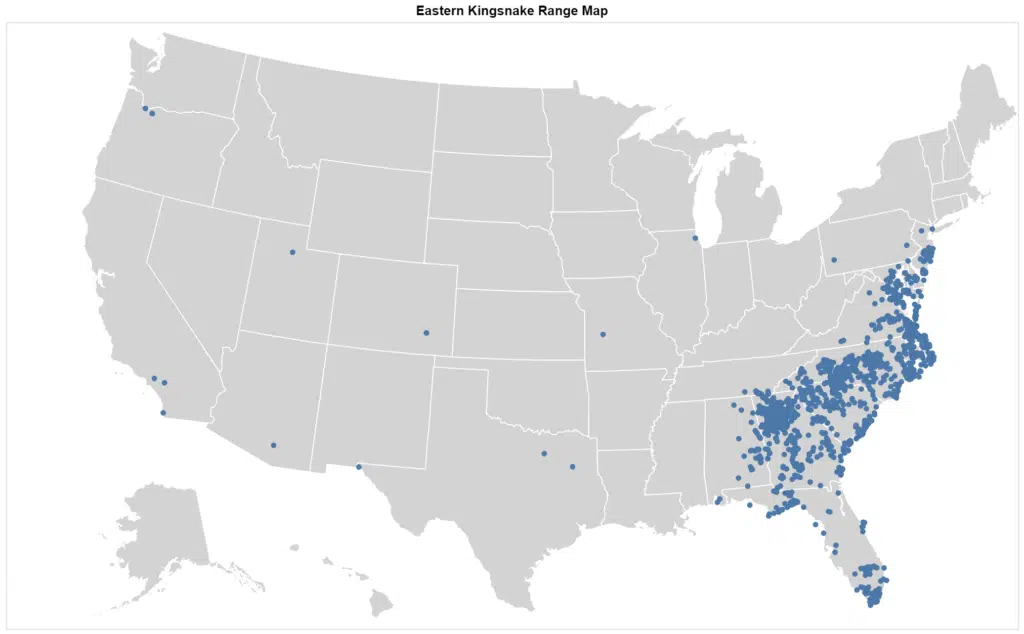
The Eastern Kingsnake is commonly seen on farms and croplands where food sources attract mammals and rodents.
However, the species is well-adapted to live in areas with scarce water supplies such as deserts.
Given it has plenty of food, a snake of the species can become sexually mature within a few years.
It takes up to 2.5 months for young snakes to emerge. All juveniles are vividly colored as opposed to dark-colored adults.
5. Ring-necked Snake
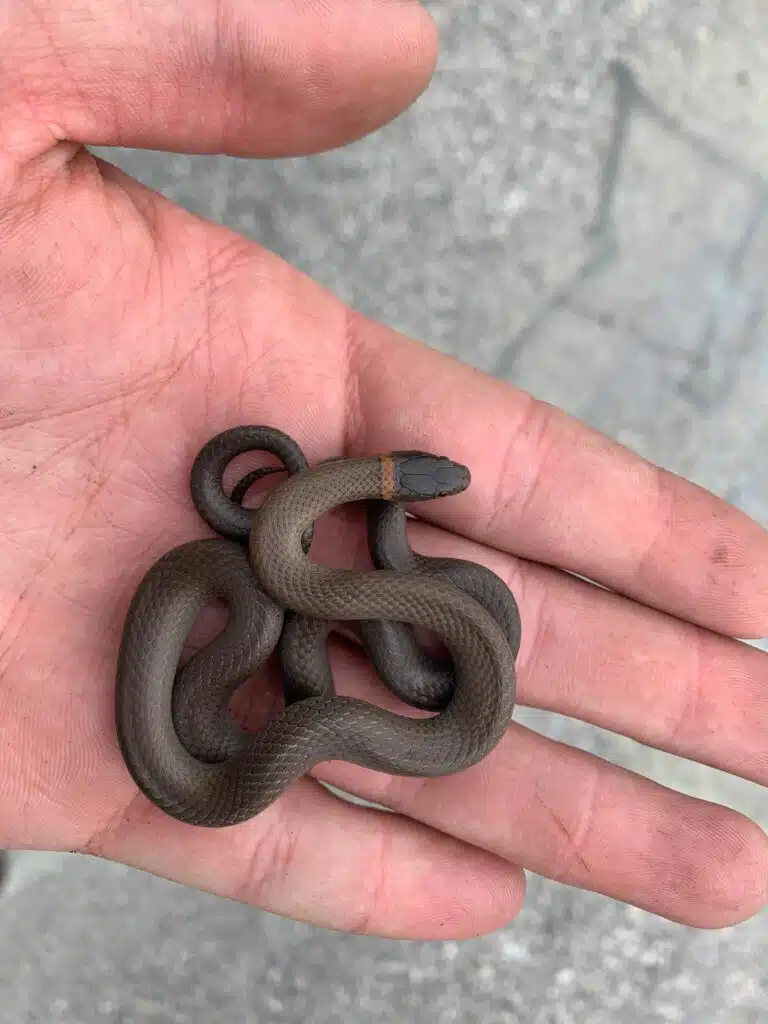
Scientific name: Diadophis punctatus
Venomous: No
The Ring-necked Snake gets its name from its bright ring around its neck, just behind its head.
This snake is found in different colors from gray to olive and even black.
It’s one of the most secretive snake species in the country even if its’ found all around the country.
This snake can sometimes be black as a juvenile as well. Many juveniles are all-black with an off-white neckband.
A smaller percentage of juveniles are black with a red tail tip.
These snakes are also known to be venomous even if they don’t have a venom gland as other highly venomous species.
Growing to a length of around 15 – 18 inches, Ring-necked snakes are known to use venom only against small animals such as frogs.
This indicates it doesn’t use venom for defensive purposes.
Apart from using venom, this black snake can also use the physical constraint to suffocate its prey.
Frogs and even juvenile snakes of other species are known to be subdued by constraint.

These snakes are sometimes seen together, but only in cold climates when they need to share a den to stay warm.
Any type of hole in the ground that allows these snakes to crawl into can be shared by multiple Ring-necked snakes.
These are typically deep holes that offer shelter from freezing temperatures. Most are located under dense vegetation as well.
6. Mudsnake
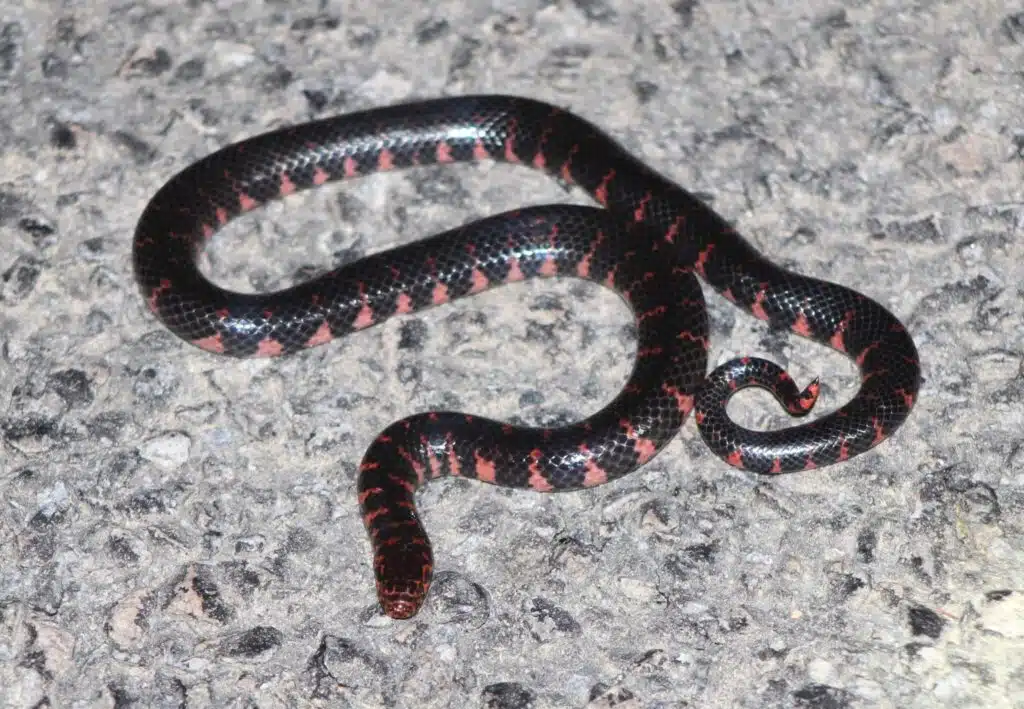
Scientific name: Farancia abacura
Venomous: No
The Mudsnake has many nicknames. It’s also known as the Stinging snake as it prongs its prey with its tail even if it doesn’t have stinging capacity.
This is a shiny black snake with a black body and red and black underside coloration.
With a mostly black body, this snake can sometimes be difficult to see from above, especially since it’s a water snake.
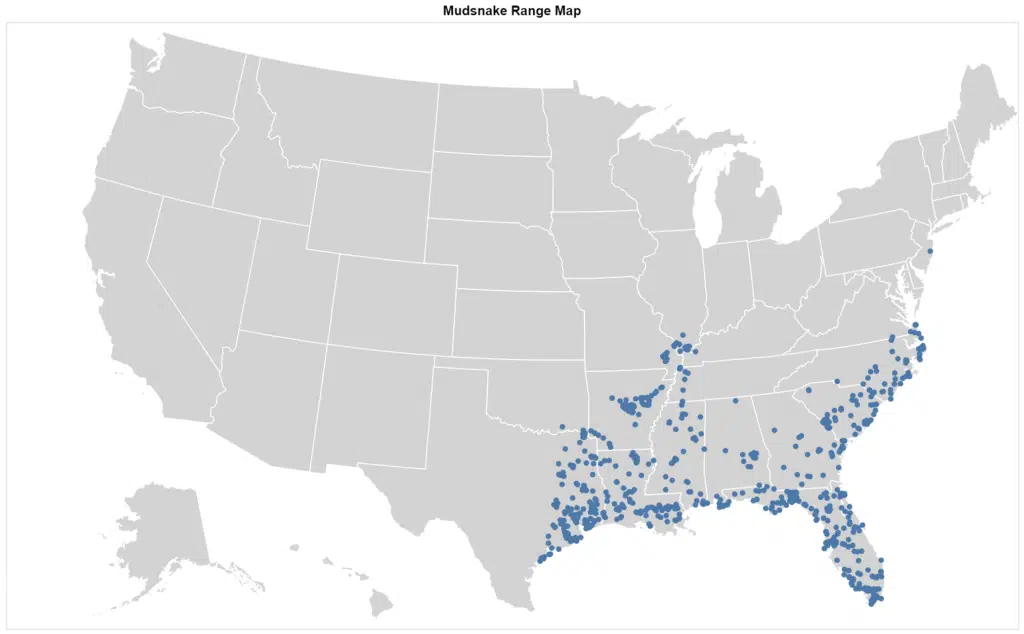
Found in Florida, Louisiana, Kentucky, and other warm states, these snakes are also nocturnal which further decreases the chances of actually seeing one out in nature.
This species grows to just over 40 inches as an adult, on average. Some of the largest examples of Mudsnake have been shown to measure up to 80 inches.
Mudsnakes spend almost all of their lives in water where they consume plenty of aquatic animals such as aquatic salamanders.
Mudsnakes eventually make their way on dry land to either lay eggs or to enter a state similar to hibernation.
The species has also been shown to seek refuge on dry land over periods of high drought where it needs to seek shelter until normal water levels return.
Mudsnakes typically bury themselves in the mud where they practice a waiting game when it comes to praying. These snakes make their way to dryland to lay eggs after reaching sexual maturity.
Most Mudsnakes lay varying numbers of eggs from a minimum of 6 and a maximum of 104.
7. Western Worm Snake
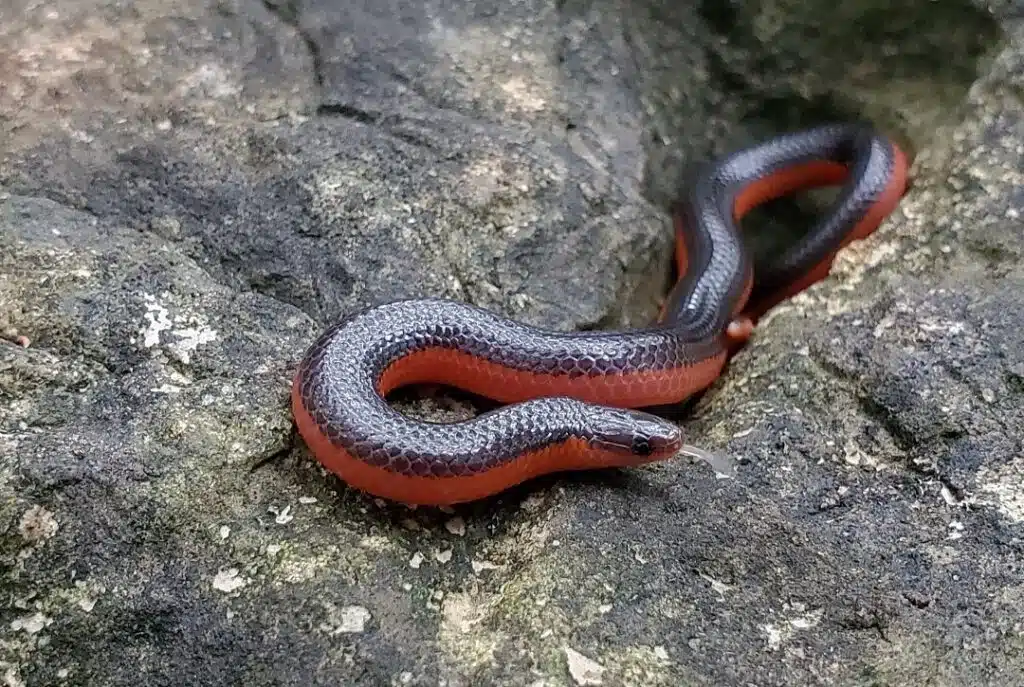
Scientific name: Carphophis vermis
Venomous: No
The Western Worm Snake is similarly-colored to Mudsnakes. It has a mostly black body with either red or pink bellies.
Juvenile Western Worm Snakes look completely different from adults. They have a gray-brown body with a white underbelly.
These snakes are considerably smaller than Mudsnakes, on the other hand. They grow to a maximum length of 11 inches.
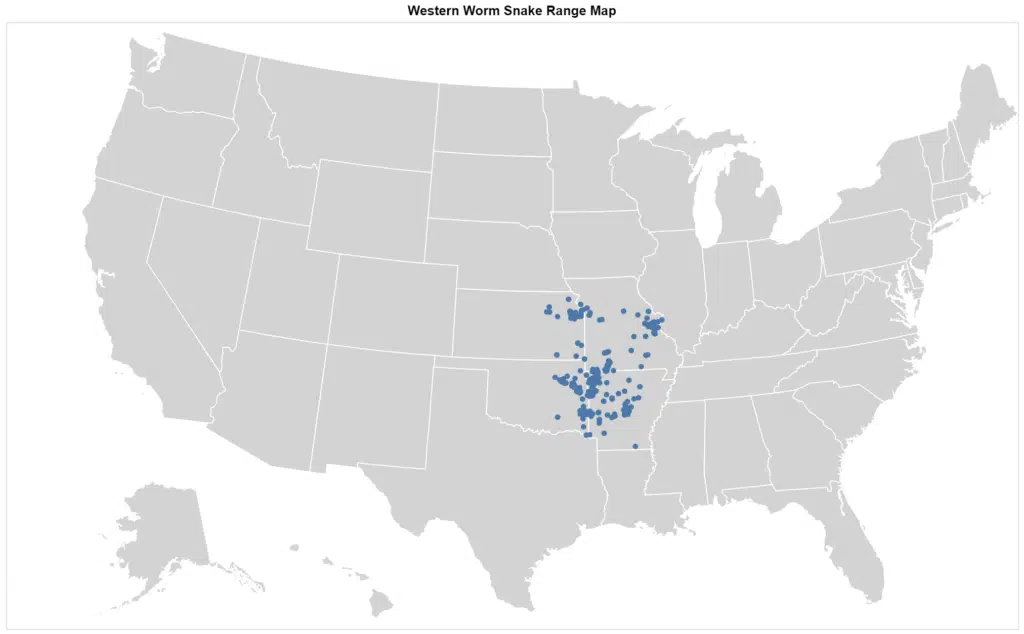
Western Worm Snakes spend most of their lives underground, which means people rarely see them.
They prefer damp soil habitats are and common in Nebraska, Kansas, Iowa, Louisiana, and Oklahoma.
Snakes of these species are known for mostly eating earthworms which is why they spend most of their lives in damp soil with high chances of finding earthworms.
These snakes are sometimes found under rocks where they lay eggs. They lay a limited number of eggs compared to other species.
Up to 12 eggs are laid at once by the snake.
This is one of the few times this snake is seen at the surface as it tends to go even deeper underground when temperatures drop to avoid frozen surface soils.
As Mudsnakes, the Western Worm snake is also known for pronging its prey with its tail. However, it doesn’t sting its prey.
Further Reading:
8. Arizona Black Rattlesnake
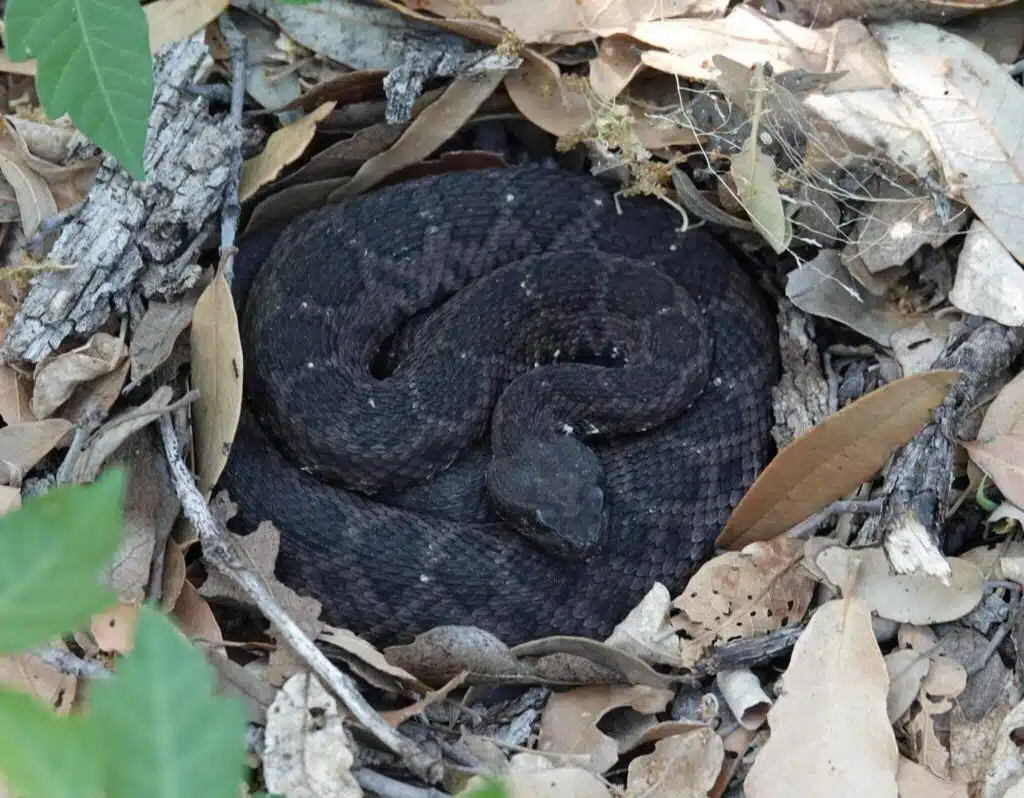
Scientific name: Crotalus cerberus
Venomous: Yes
The Arizona Black Rattlesnake is found in different colors. Commonly seen in all-black coloring, this snake can also be found in gray and dark gray with markings coloring.
Juvenile Arizona Black Rattlesnakes are known for showing more marks on their bodies compared to adults.
One of the distinct traits of the species is the ability to change color.
These snakes can quickly change colors as adults, which is believed to be a mechanism to avoid detection depending on their environment.
Arizona Black Rattlesnakes can change color just as chameleons. Cromathopores are responsible organs for this ability.
These snakes are common in forests and grasslands. They prefer crawling beneath leaves on the ground to avoid detection.
The Arizona Black Rattlesnake female gives birth to live juvenile snakes. These snakes are shown to be cared for by the female for up to 2 weeks.
Studies show the Arizona Black Rattlesnake is one of the social species of black snakes. It commonly lives in groups.
Most groups are made out of members of the same family as well as by unrelated snakes.
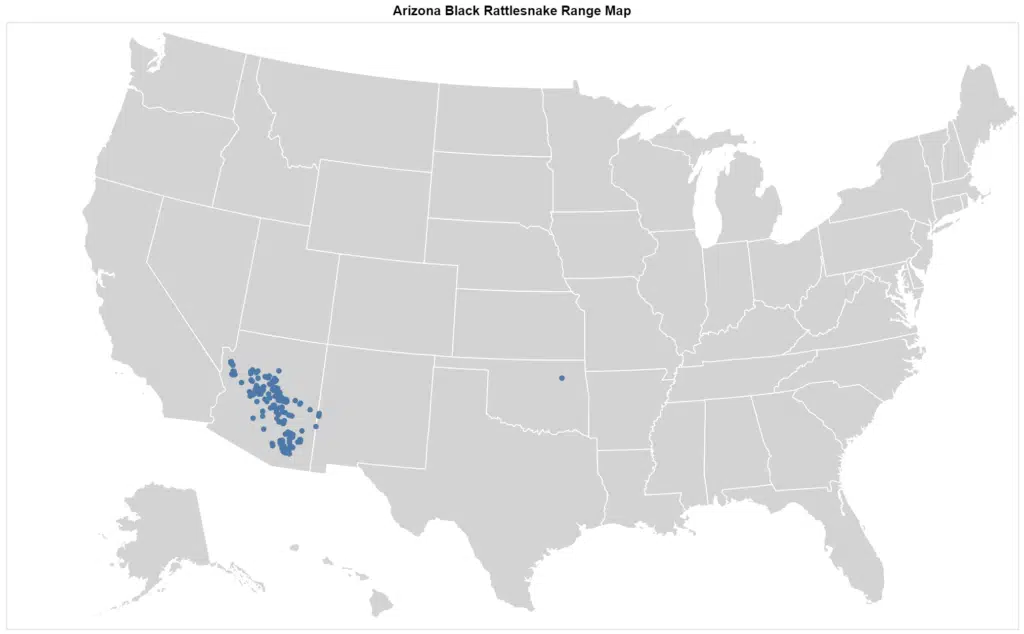
Commonly found in regions of Arizona, the species has a wide diet given it grows to a considerable size.
Arizona Black Rattlesnakes grow to a maximum size between 31 and 43 inches.
They eat small mammals, lizards, and even birds.
9. Black Swampsnake
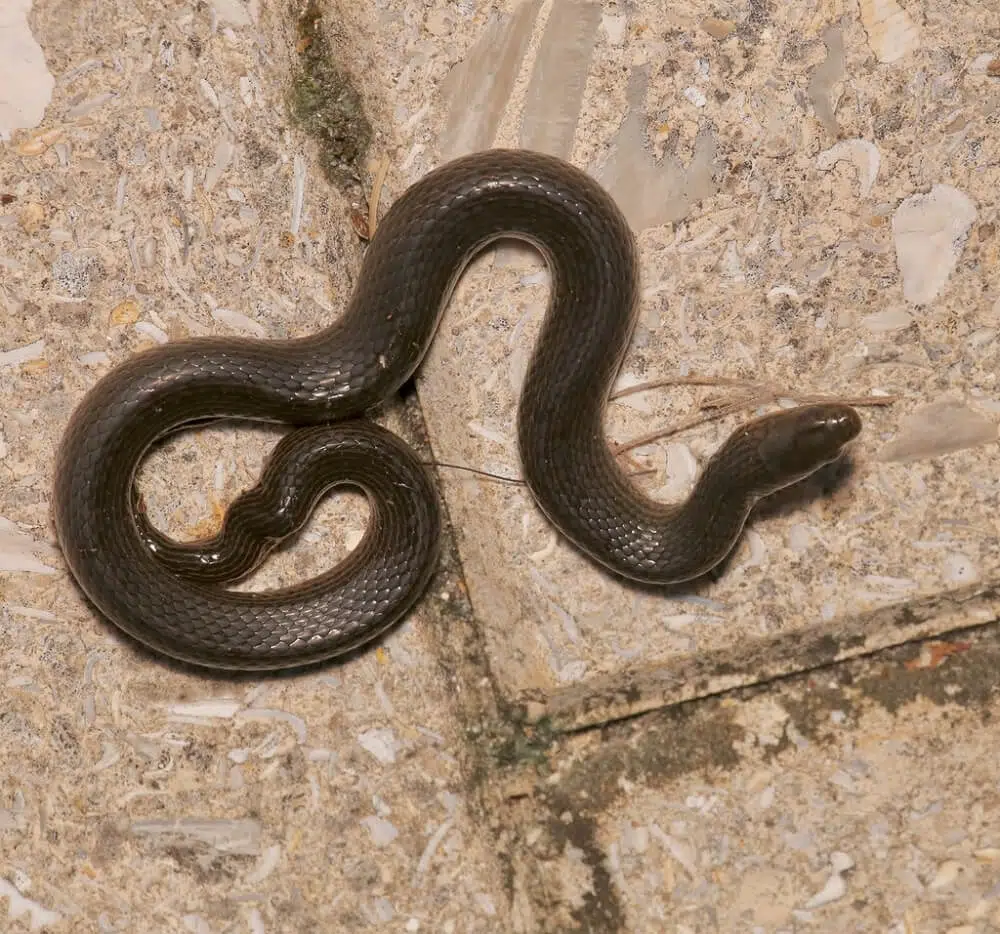
Scientific name: Liodytes pygaea
Venomous: No
The Black Swampsnake is common in Florida, North Carolina, South Carolina, and Alabama. They prefer to live in the water or swamps, particularly cypress swamps.
These nocturnal snakes have a black body with a red belly. They grow to an average length of 30 inches while the largest examples to have been found measure more than 60 inches.
Snakes of Black Swampsnake species are part of the Colubridae family. Females give birth to live snakes and they have been shown to feed more while gravid.
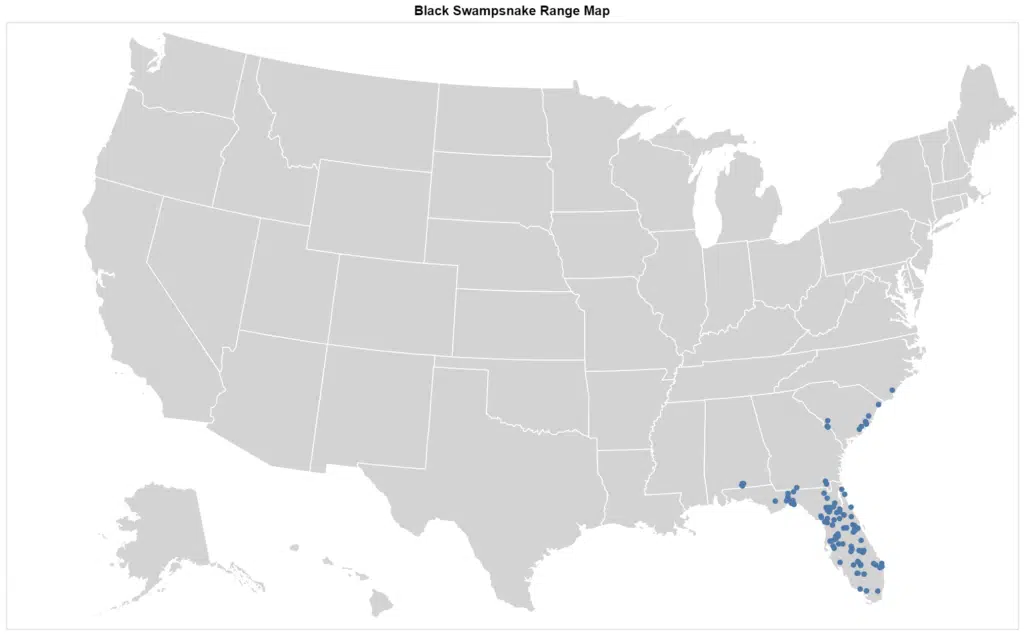
This potentially suggests female Black Swampsnake pass nutrients to live young snakes.
Females give birth to a small number of live snakes. Anywhere between 2 and 15 live snakes are born until October each year.
This species isn’t venomous. Even seeing people it doesn’t bite. It looks for means of quick escape.
Some of these snakes can be opportunistic eaters. However, most Black Swamsnakes prefer a diet specific to swamps where they find animals such as tadpoles, frogs, sirens, and small fish to feed on.
10. Eastern Indigo Snake
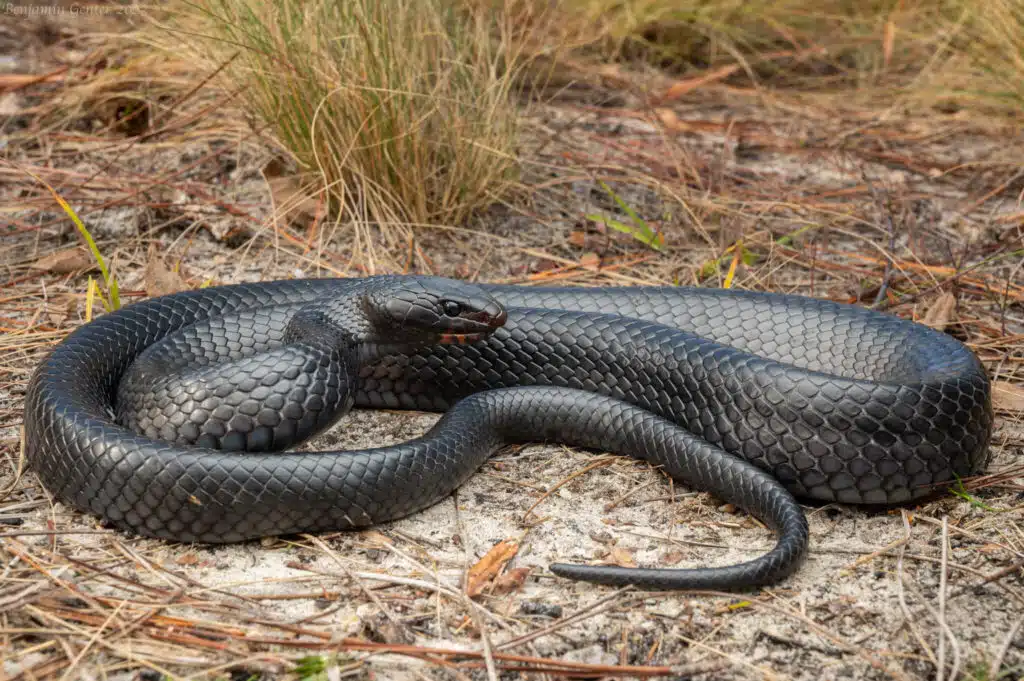
Scientific name: Drymarchon couperi
Venomous: No
The Eastern Indigo Snake is a primarily black snake with red coloring on its chin. This snake is known for having size differences from males to females.
The average male length is 7.7 feet while the average female measures around 6.6 feet on average.
Unlike many black snakes, the Eastern Indigo Snake looks similar both as a juvenile and as an adult.
Females lay up to 13 eggs at a time with hatchlings measuring at least 600mm.

The species is considered threatened in Georgia and Florida. A diminishing natural habitat is the main cause of its dwelling numbers.
These snakes need good communication between their natural habitats and areas covered with leaves to freely move around. These requirements aren’t met in areas with heavy industrialization.
A non-venomous nature characterizes these snakes. Defensive techniques include vibrating a tail
11. Pine Snake
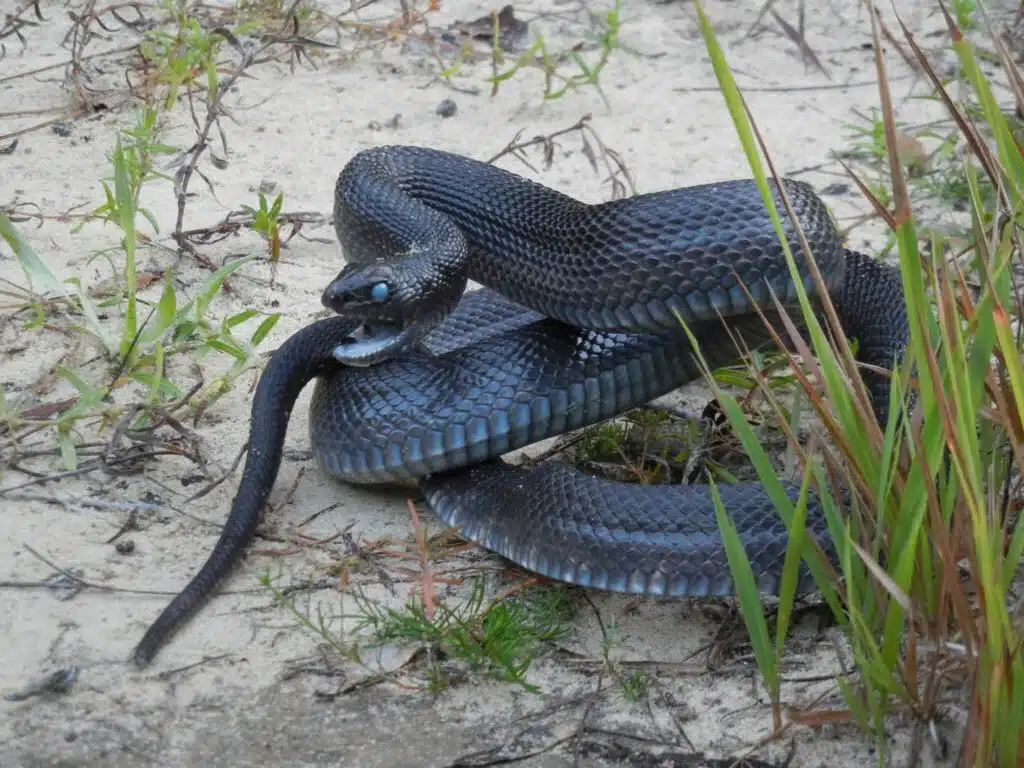
Scientific name: Pituophis melanoleucus
Venomous: No
The Pine Snake is also known as the Bullsnake and the Black and White snake.
Pine Snakes are known for having a mostly dark-colored body where black and various shades of gray are dominating. The snake is further identified by a small head for a Colubrid species.
Pine Snakes are still common in states such as Georgia and Florida. However, there are listed as threatened and protected in certain states given it has already disappeared from areas such as West Virginia.
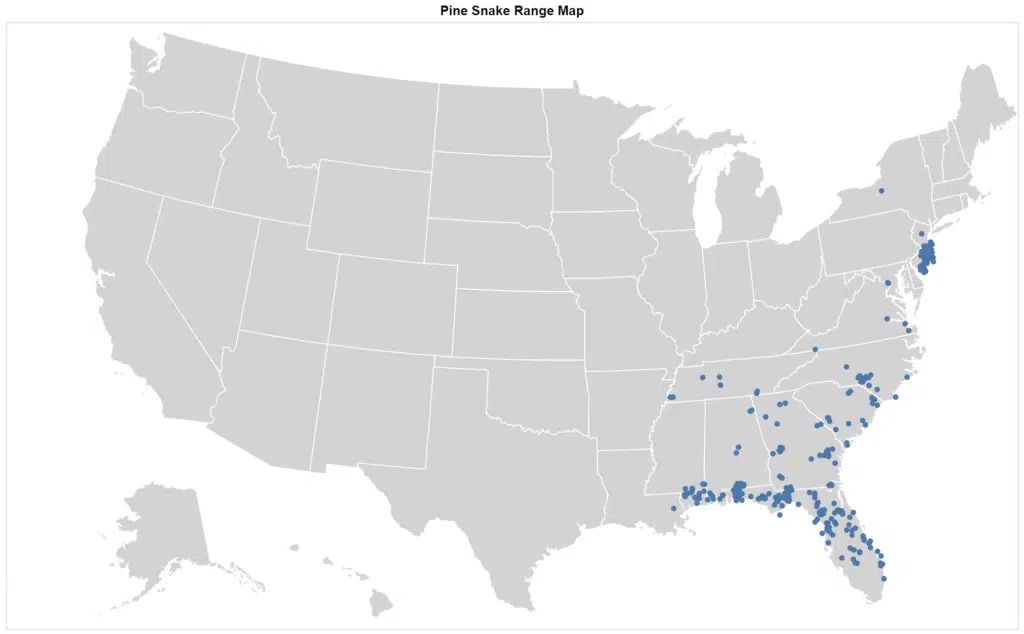
Pine Snakes carry eggs that they deposit together with other eggs of the species. These are snakes that live together and even laying eggs is a social activity where all eggs are deposited in the same place.
Growing to a maximum size of 66 inches, these snakes are rarely seen since they spend most of their time underground.
Pine snakes live in underground communal nests. Most of these nests are found in sandy or loose soils easy for the snakes to crawl through.
Some of their nests are found next to abandoned fields while others are found in the vicinity of pine forests.
12. Western Ratsnake
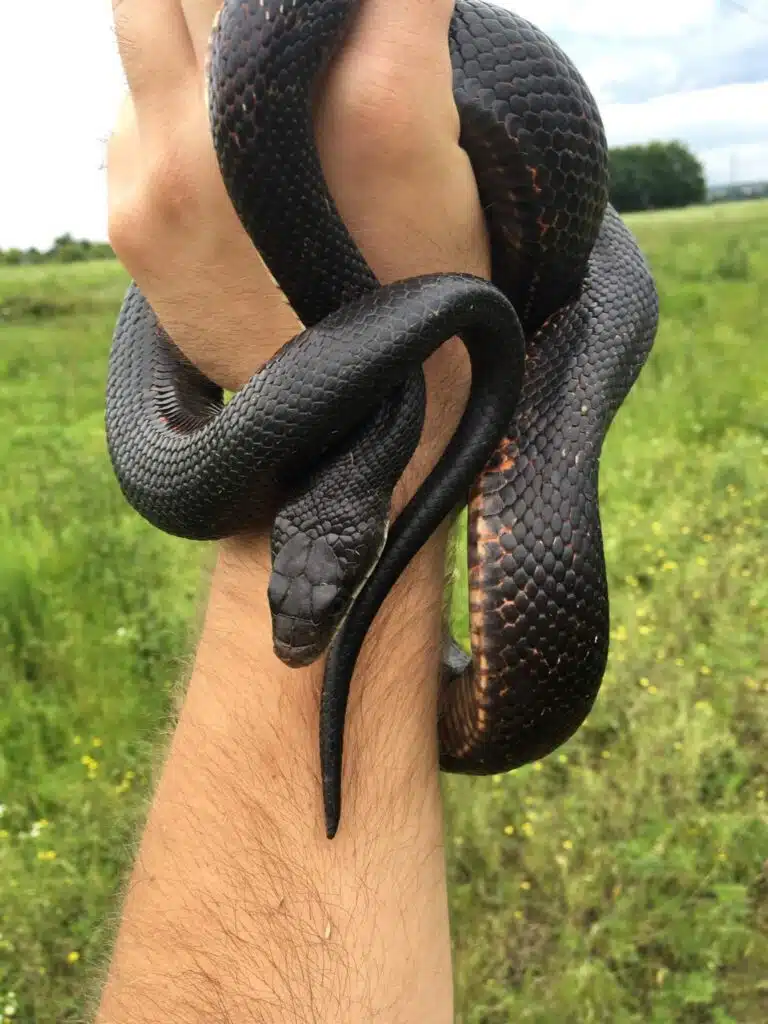
Scientific name: Pantherophis obsoletus
Venomous: No
Also known as the Black Coluber or the Chicken Snake, the Western Ratsnekae is one of the rare aggressive black snake species.
This snake tends to become very aggressive when cornered, but it’s not venomous.
One of the reasons many believe it to be venomous is its ability to live communally sharing the same den with venomous snakes such as Copperheads or Rattlesnakes.
Western Ratsnakes are spotted in various states around the country frequently as they live above the ground.
The snake is a very good tree climber. It doesn’t need any branches to make its way up trees which is why it’s also considered an agile species.
These snakes are known to prey on a large series of birds. Western Ratsnakes don’t back down from attacking hawks such as the red-tailed hawks.
Excellent muscle strength allows it to overpower some larger bird species such as hawks. However, Western Ratsnakes only attack large prey when they become larger themselves.
The snake commonly attacks large prey only when it reaches a length of around 60 inches.
Further Reading:
13. Plain-bellied Water Snake
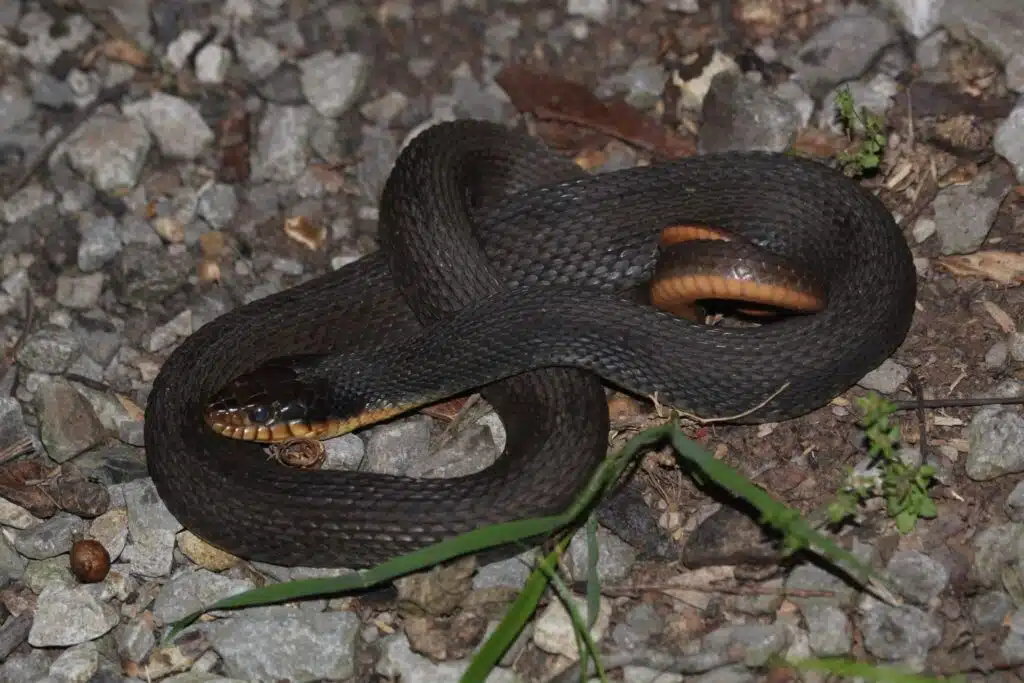
Scientific name: Nerodia erythrogaster
Venomous: No
Common in states such as Texas and Oklahoma, nonvenomous Plain-bellied Water Snakes are found in various colors from dark olive to all-black.
These are semi-aquatic snakes able to spend a long time both in water and on dry land. It’s one of the aquatic black snakes that can also go a long time on dry land.
Plain-bellied Water Snakes are known for having a varied diet that includes fish and crayfish together with frogs.
These large snakes swallow prey completely without using physical constraints.
Plain-bellied Water Snakes also have many types of predators. These snakes are hunted by hawks and Kingsnakes among other species.
It uses different escaping tactics when captured or before being captured. A Plain-bellied Watersnake will make its way to dry land to escape aquatic predators such as other aquatic snakes.
When captured by hawks, this snake releases a foul smell and it resorts to biting to force an escape.
Female Plain-bellied Water Snakes are known to give birth to as many as 18 live juveniles. This happens in August or September.
Are Black Snakes Poisonous?
Black snakes are largely nonvenomous. These snakes are known for having a non-aggressive nature in general.
Some black snakes are wrongfully associated with venomous snakes and even misidentified with venomous snakes as they share the same den.
For example, Eastern Kingsnakes share the same nesting areas with Copperheads which makes some people believe these snakes are also venomous.
Non-venomous
Most black snakes aren’t venomous. Species such as the Eastern Kingsnake or the Mudsnake aren’t venomous.
Many black species have a ‘taping’ tactic with their prey. They use their tails to tap the prey as a means of investigation but they don’t pierce prey.
Mildly venomous
Mildly venomous black snakes such as the Ringneck snakes aren’t true venomous snakes as they don’t have a venom gland.
However, their saliva is mildly venomous and used to paralyze some types of prey.
Summary
Black snakes are found throughout the US, particularly in states such as Florida, Georgia, North Carolina, South Carolina, and Arizona.
Many black snakes are aquatic, semi-aquatic, or they live underground which can sometimes make them hard to see.
Black snakes can be known to fully develop in black coloring as they mature.
Many black snakes are colored or grey as juveniles, only becoming true black snakes as they reach adulthood.
Most black snakes aren’t venomous. They use physical constraints with prey or they swallow prey without any constraints.
Black snakes typically flee when encountering humans. Some may be known for vibrating their tails and for becoming potentially aggressive, but they rarely bite.
Many black snakes live in common pits with venomous snakes which can sometimes make them appear as venomous as well.
This den sharing nature of these types of snakes can also be seen in the way they lay eggs together with the eggs of other snakes of the same species or other snake species.
Further Reading: